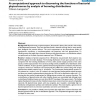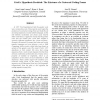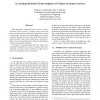520 search results - page 30 / 104 » Computing recombination networks from binary sequences |
BMCBI
2006
14 years 12 months ago
2006
Background: Phytochromes are photoreceptors, discovered in plants, that control a wide variety of developmental processes. They have also been found in bacteria and fungi, but for...
BMCBI
2007
14 years 12 months ago
2007
Background: With the advent of increasing sequence and structural data, a number of methods have been proposed to locate putative protein binding sites from protein surfaces. Ther...
AINA
2007
IEEE
15 years 3 months ago
2007
IEEE
In 1957 Crick hypothesized that the genetic code was a comma free code. This property would imply the existence of a universal coding frame and make the set of coding sequences a ...
107
click to vote
PERCOM
2005
ACM
15 years 5 months ago
2005
ACM
When ubiquitous computing devices access a contextawareness service, such as a location service, they need some assurance that the quality of the information received is trustwort...
108
click to vote
IJCNN
2000
IEEE
15 years 4 months ago
2000
IEEE
In this paper neuro-fuzzy synergism is applied to implement content sequencing in adaptive hypermedia systems. The level of understanding of the learner is used to construct lesson...



